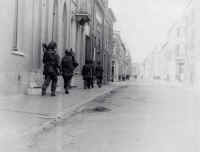[Home] [Events] [Links] [Guestbook] [Contact Us]
89 (Parachute) Field Security Section
317 (Airborne) Field Security Section
Operational Duties
In the early days training in field security duties was conducted by the CMP at Mytchett, but it subsequently moved to Winchester as the Field Security Training Centre and Depot (via a short period at Sheerness). This centre managed to turn out 77 fully trained sections by December 1940.
Field
Security (FS) duties were covered by the Manual of Field Security
(1943). The tasks included:
(1) Compiling and using Black and White Lists from information
provided from multiple sources including the Secret Intelligence
Service (SIS), Special Operations Executive (SOE), and Ultra.
Black Lists were for the arrest of known enemy intelligence operatives
and sympathizers / collaborators. White Lists used for the
contact with local resistance and friendly persons.
(2) Arrest and Field Interrogation of Black List/high category
prisoners (INT CORPS personnel were often selected for language skills)
such as the SS, Gestapo, the SD, local Nazi/sympathizers.
(3) Searching of captured enemy HQ/Intelligence offices, etc for
valuable intelligence information and translation of documents.
(4) Briefing Division and Brigade intelligence staff officers
with information derived from the above.
(5) Key point security and security investigations prior to
operational deployment..
Field Security Section (FSS) units were deployed with the British Army wherever it operated. Successively in North Africa, Italy, France, the Low Countries, Germany and Austria, and the Far East. They operated normally at Brigade to Division level and usually at the forward edge of advance.
Operationally, the FSS were responsible to the formation HQ General Staff Officers - GSO 2 (Int), working with the GSO 3 (Int) - and for technical and policy issues, FSS were responsible to INT CORPS (Field). For domestic issues, the parent formation were responsible for things such as: accommodation, equipment, communications, feeding, etc.
When FS tasks were not conducted, that is for example at home, the security of unit and location became a priority, such as before operational deployments (e.g. Op OVERLORD), and on deployment. When FS tasks could not be conducted due to enemy action, the units fought as infantry, such as in Op MARKET in Arnhem, 1944.
6th Airborne Division Intelligence Officers
Capt. John Max,
6th Airborne Division
Capt Phillip Hodgson, GSO
3(Int),
1st Airborne Division HQ
89FSS, Training
Capt. John Killick,
Arnhem 1944
Capt. Killick's Patrol, Arnhem 1944
Capt. Killick's Patrol, Arnhem 1944


![Max[1].jpg (115305 bytes)](images/Pic_Historic/Pic_Historic_th/Max1_small.jpg)
![Hodgson[1].jpg (211200 bytes)](images/Pic_Historic/Pic_Historic_th/Hodgson1_small.jpg)
![89[4].jpg (67068 bytes)](images/Pic_Historic/Pic_Historic_th/894_small.jpg)
![Killick[3].jpg (108669 bytes)](images/Pic_Historic/Pic_Historic_th/Killick3_small.jpg)



